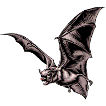Museum, University of Nebraska State

University of Nebraska State Museum: Mammalogy Papers
Document Type
Article
Date of this Version
10-1978
Citation
Carnegie Magazine (October 1978) 52(8): 22-27.
Abstract
The thought that "Bats are Beautiful" may bring a smile to your face as you think of these ugly little creatures hanging from the ceilings of haunted houses and flying around deserted bell towers at midnight. You may also remember old wives tales such as "all bats have rabies" or "bats try to fly into women's hair." None of these things is completely true, and some of the tales have no basis in fact whatsoever.
Actually, the 875 species of bats form a unique Order of mammals (those animals possessing hair at least somewhere on their bodies), since they are the only mammals capable of true flight. The flying squirrel familiar to many western Pennsylvanians actually only glides from one place to another. Bats occur almost everywhere in the world except in the coldest regions, such as the Arctic, Antarctic, and the most remote oceanic islands. One reason that very little has been known about bats is that they are active at night, so they are difficult to observe. This association with darkness is one of the main factors in our association of bats with witches and devils, and our general misgivings about them. However, in many areas the careful observer can see bats in the evening just at twilight as they leave their daytime roosts or dart about catching insects. In the daytime, bats seek refuge in a wide variety of places such as caves and mines; the branches and hollows of trees; houses, barns, and other man-made structures; rock crevices, under rocks, and many other places.
For the past six years, we have been studying bats of the Family Phyllostomatidae, the New World leaf~nosed bats. These animals occur throughout the tropical portions of North and South America with a few species reaching as far north as the Southwest of the United States. Some species also occur on the Caribbean islands, where we have been conducting our most recent studies. During the summer of 1977 we, along with Dr. John W. Bickham of Texas A & M University, visited the island of Jamaica to complete our studies of the bat fauna of the island. This work was supporte, by a grant from the M. Graham Netting Research Fund of Carnegie Museum of Natural History.
Included in
Biodiversity Commons, Other Ecology and Evolutionary Biology Commons, Terrestrial and Aquatic Ecology Commons, Zoology Commons


Comments
Copyright 1978, Carnegie Institute. Used by permission.